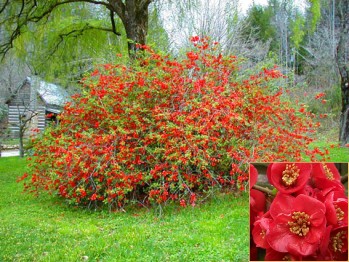
|
|
Chaenomeles
- Flowering Quince (Chaenomeles
japonica speciosa)
|
Chaenomeles
- Flowering Quince (Chaenomeles
japonica speciosa)
This group consists of three hardy, deciduous shrubs from eastern
Asia, commonly known as Flowering Quinces. These thorny shrubs are suitable for growing against
walls, in borders and standing alone. Flowering Quinces are easily grown and are valued for their
saucer-shaped blossoms, which may be red, pink, orange, or white and are followed by
large, fragrant fruits. (The plant that is grown for its edible fruits
is, Cydonia, the orchard Quince.)
Flowering quinces
(Chaenomeles speciosa) are grown for their warm-colored flowers and
thorny, gray-brown branches. Waxy flowers emerge before or during the first flush of growth in early spring -- anywhere from late January through March in the
South, March and April in northern regions. Individual flowers are borne on the
branches, looking something like apple blossoms in their form. Some have a single ring of
petals, others many overlapping ones.
Flowering quince braves the unpredictable early-spring weather to provide an explosion of color that arrives weeks before that of other
spring-flowering shrubs. The flower color depends on
the cultivar grown.
When in flower, the shrubs attract bees.
Cut branches with swollen flower buds may be
forced indoors, making a welcomed winter flower arrangement. To prune,
remove only crossing, diseased or broken branches. Flowering quince
should never be sheared.
This deciduous, broadly spreading shrub grows anywhere from 6-10 feet tall and spreads as
wide. The 1 1/2- to 3-inch leaves are bronzy in early spring before they turn
dark, glossy green.
In fall, quinces produce hard, greenish-yellow fruit about 2 inches in
diameter.
The
fruit is not ornamental, it is very astringent, so it's no good to eat
raw. But have a high pectin
content and reportedly makes a tasty jelly or marmalade.
Recently
European industry try to grow Japanese quinces in wide range crops but
not for onramental purpose. The general objective of the project is to develop Japanese quince (Chaenomeles
japonica) to a competitive European industrial multi-purpose crop
for production of juice, flavour, and fruit fibre. The project aims at
carrying out necessary fundamental and applied research on Japanese
quince to investigate limits and potentials from agronomic, biological,
technological and economical point of view. In particular, the project
focuses-on the biological potentials as a base for commercial processing.
Source:
http://www.greenbeam.com/features/plant080299.stm
http://www.msue.msu.edu/imp/modzz/00000335.html
http://www.bushesandshrubs.com/common_names/
red_flowering_quince.shtml
http://www.nf-2000.org/secure/Fair/F912.htm
http://www.botany.com/chaenomeles.html
